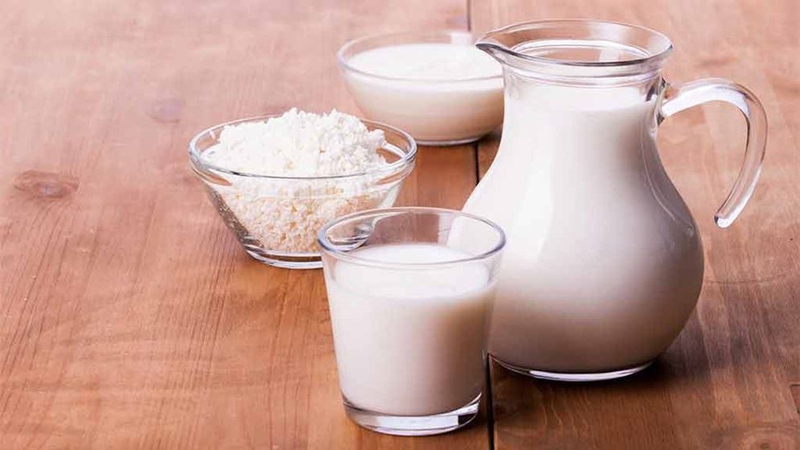It is true that the dairy section at the grocery store can leave you confused. A simply thing like buying milk can cause all sorts of confusions, especially with so many brands available with different types of options, including fat-free milk, skim milk, low-fat milk, organic milk, lactose-free milk, and the list goes on. Many people think that fat-free milk and skim milk are the same, but are they really the same? Skim milk vs. fat free milk here tells you the real story. Let's find out more about it to understand which option works better for you.

Skim Milk vs. Fat Free Milk
Skim Milk Facts
Removing the top layer of fat or cream from the dairy milk was the conventional method of preparing skim milk. Machines are now available to help remove the fat, and this type of milk is called 'skim milk' in the United States, but the people in the UK and Canada calls it 'skimmed milk'. In a glass (16oz) of skim milk, you have 316mg of calcium, 90 calories, and less than 0.5% of fat. It also contains phosphorous, magnesium, and vitamin A and D, which are usually added during processing. Therefore, skim milk is more nutritious as compared to whole milk.
Fat-Free Milk Facts
The simple difference is that skim milk may have a reduced percentage of fat, but fat-free milk, as the name suggests, has a negligible amount of fat. Skim milk may have up to 2.5% of fat, whereas the fat content of fat-free milk is close to none. You can check the label to get an idea about how much fat is there in the product. The labels can be confusing though, as most mention '1% milk' or '2% milk', but it actually refers to their fat percentage. It is important to point out that in many countries, you can find skim milk being sold under the label of fat-free milk, but you have to know that it still contains some fat and is not free of any fat as implied by the name.
Legalities
United Sates Department of Agriculture (USDA) has made some changes to the laws pertaining to milk labeling. They have recognized four types of milk and differentiated them on the basic of their fat content. For instance:
Whole Milk: It contains minimum fat, but the fat content may still be up to 3.25%.
2% Milk: It has a reduced fat content, usually between 2.0% and 2.5%.
1% Milk: It also has a reduced fat percentage, but usually between 1% and 1.5%.
Fat-Free Milk: It usually has no fat, but the fat content usually stays between 0% and 0.5%.
Which Type of Milk Should You Drink?
A simple comparison of skim milk vs. fat free milk helps you decide which type is more suitable for you. Your fitness goals will help you make a decision. Keep in mind that fat-free milk is also skim milk, but the percentage of fat is usually less than 0.5%. Both 1% milk and 2% milk are considered skim milk, and even though the fat percentage is very low, it is still a bit higher than what you have in fat-free milk.
However, the difference is usually so small that you do not really get more benefits by preferring one to the other. The only thing you need to ensure is that you are not going for whole milk, as it contains saturated fat, which leads to cardiovascular disease. Choose low fat or skim milk to lower your risk of heart disease. It is important to mention that some experts are of the view that the procedure of making skim milk is not appropriate, mainly because dry milk powder is included to improve its protein content. Not only does milk powder lack important nutrients, it also triggers oxidation of milk's cholesterol. This in turn can actually increase your risk of cardiovascular disease.
Overall, a comparison of skim milk vs. fat free milk shows that there is little or no real difference between the two. Fat-free milk is actually skim milk with a very low fat content, and the label is used only as a marketing tactic to encourage fitness conscious people to buy it and think they are not getting any fat through milk. The fact remains that skim or fat-free milk is always better than whole milk, especially for overweight people. Underweight people can include whole milk in their diet.
How to Incorporate Skim Milk or Fat Free Milk into the Diet
You can drink fat free or skim milk with breakfast, lunch, and dinner. A glass of warm skim milk serves as a perfect bedtime snack – it relaxes your body and helps you fall asleep. You do not always need to drink plain milk – you can add it to a bowl of whole-grain cereal or make smoothie using milk, fresh strawberries, and frozen bananas.
Both skim and fat free milk can be used as a base for rice dishes, buckwheat pancake batter, homemade soups, mashed potatoes, and pasta dishes. You can also replace water with fat-free milk in condensed soups, cream of wheat, cream of rice, and oatmeal. You just have to make a few simple changes to your diet to incorporate milk in your diet. Just keep in mind that you should only get three servings of dairy products a day.
View All Comments /Add Comment